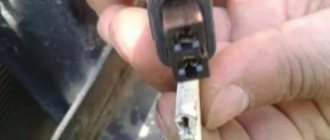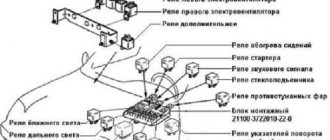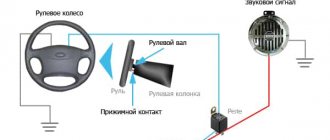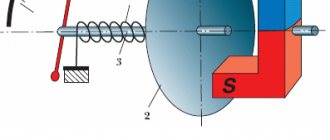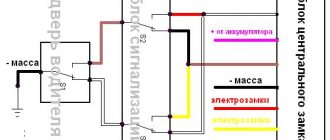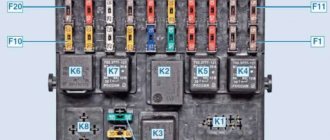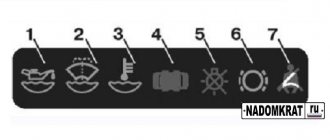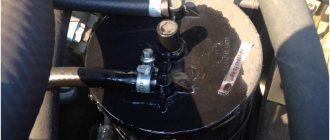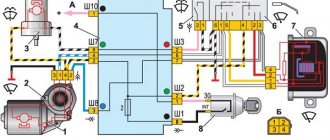Why the signal does not work on the VAZ-2107 and what to do
A car horn is a very important detail that ensures traffic safety and helps prevent collisions with other cars and a collision with a pedestrian who suddenly runs out onto the road. Different car models use different horn designs, but in our article we will talk about the original VAZ-2107. From it you will learn on what principle the signal works, what modifications of it can be used in these machines, and also what to do in the event of a breakdown.
Where is the signal located on a VAZ-2107 car?
The domestic automaker is releasing to the market several modifications of the VAZ-2107 car model, which is beloved by consumers. The design and location of each of them has a number of its own features:
- in some versions of the car, only one sound signal is used, which is mounted immediately behind the front lining of the cooling radiator. In this case, you can easily reach the part and replace it if the need arises;
- A number of modifications are equipped with two sound signals at once. They are installed directly behind the radiator and have different tones, which makes it possible to quite loudly warn pedestrians and drivers of other cars about the possible danger of a collision.
The RS-528 sound signal relay is mounted in the mounting block of both machines, which is often one of the main causes of breakdowns of this part.
In addition, the circuit can include fuse F7, which prevents the supply of excessively high voltage and its surges, as well as a button located directly on the steering wheel.
Checking the functionality of the relay and fuse
What to do if the signal on a VAZ-2107 car does not work, and for what reasons can it fail?
The most common one is a blown fuse. Under increased load, it fails and interrupts the electrical circuit, thereby eliminating more serious emergency situations. If you are faced with the problem of a blown fuse, you must replace it immediately. In addition, you will need to carefully inspect the contacts of this part, carefully clean them of carbon deposits and dirt, or perform repairs.
The next stage of diagnostics is to check the functionality of the sound signal relay. If it clicks when you press the button, then the cause of the breakdown needs to be looked for elsewhere. Otherwise, the relay will need to be replaced, which can be done within a few minutes even without the relevant experience.
We diagnose the signal and its activation buttons
In order to find out whether your car uses a correctly working signal, you should disconnect its wires from the relay and connect them directly to the battery. If the sound does not appear in this case, the causes of the breakdown may be the following:
- contacts located directly in the device body are burnt or heavily soiled;
- The signal is not configured correctly, causing the dial tone to sound very low or not audible at all.
Troubleshooting is done by adjusting the signal (to do this you just need to turn a special screw installed in the back of the case) and cleaning the contacts.
Another reason why the signal may not work is a broken or worn button. To restore its normal functioning, you can either replace the entire part, or again put the contacts to which the wires are connected in perfect order.
As you can see, you don’t have to go to a car service center to diagnose and repair the sound signal. Almost any work can be easily done with your own hands without spending a lot of time on it. We only strongly recommend that you do not delay this, so as not to expose yourself to the risk of a traffic accident due to a non-functioning horn.
Setting the sound signal to classic
The reason for replacing the signal was that the sound on the old tone snail was not loud enough. It barely squeaks, is almost inaudible, and does not inspire trust or fear.
I decided to change it to a more powerful one. The cost of these snails at the car market was 180 UAH (about $7) + relay (about $1)
The set includes two snails: high and low tones. They also need to be installed together.
Each of the snails has an adjusting bolt that adjusts the tone of the signal; it not recommended to turn it.
And so, we assemble the snails. We still have the fasteners from the previous ones, but if you don’t have them, you can either buy them or make them yourself.
The main rule during installation is that the snails should be directed with their mouthpiece downwards , otherwise moisture and dirt will collect in them, and they will very quickly fail.
Let's move on to the connection.
Since there is already wiring from the horns to the horn button, we will not dwell on it, but will move directly to connecting the snails.
Since the currents are high, in order to remove the load from the circuit, it must be connected through a relay.
(The standard fuse block has a standard 20A fuse responsible for the signal, so there is no need for additional fuses, but if the relay comes with a slot for it, then it will not be superfluous)
We connect the signal through the relay according to the diagram below:
You can also connect old horns to them in parallel, but the sound is not much different
Examples of the signal before and after installing new snails are shown in the video below.
That's it. Everything is ready. Enjoy the result!
But remember, according to traffic rules clause 9.5 (Ukraine):
It is prohibited to sound signals in populated areas , except in cases where it is impossible to prevent a road traffic accident (RTA) without doing so.
19.10.
(Russia) Sound signals can only be used:
- to warn other drivers of the intention to overtake outside populated areas;
- in cases where it is necessary to prevent a traffic accident.
// Violation of the rules for using external lighting devices, sound signals, hazard warning lights or warning triangles will entail a warning or an administrative fine of 500 rubles. //
What to do if the signal on the VAZ-2107 does not work
Each car owner is obliged to check the functionality of the signal on his car, and in case of a malfunction, promptly fix it.
Horn functions
The signal is provided to anticipate the danger of an accident, as well as to warn pedestrians about the possible danger. The signal is received by pressing a button mounted on the steering wheel. Traffic regulations limit the use of the signal to 2 situations. The first involves informing the driver of the car being led before the maneuver. The situation falling under paragraph 2 of the traffic rules is more extensive. The following are likely:
- A person is moving through a transition into icy conditions, and the icy surface does not allow the driver to suddenly brake. Of course, a pedestrian will be able to react when he hears a sound signal.
- The driver who entered the adjacent lane may not have noticed you in the side view mirror and began to change lanes. By signaling, you will be able to attract attention.
- There may be an animal on the roadway. Using the horn you can drive him out of the way.
- When leaving a secondary road, your car may not be noticed by another driver heading towards the main one. In this case, the sound signal will help stop his car.
- A cyclist rides in the center of the road, not from the edge. The signal will force him to let a moving car pass.
And there are many similar situations. Justified and timely use of a sound signal will protect road users and help avoid possible danger.
About the signal of the domestic VAZ-2107
The manufacturer equipped the 2107 VAZ 2 models with 2 signal modifications:
- The first option is equipped with 2 sound elements. They have low and high tonality (S-304, S-305). This made it possible to obtain surround and loud sound. These components were equipped on a metal bracket under the hood near the cooling radiator.
- The second option involved installing one signal labeled 20.3721-01. It is also located on a metal bracket in the place where the cooling radiator is located. By the way, all sound parts are non-separable and therefore cannot be repaired.
Sound horn on VAZ-2107: causes of malfunction
A signal failure on the 2107 VAZ model suggests the following:
- the signal completely stopped functioning;
- the sound is very weak and hoarse;
- spontaneous sound signal.
Unnatural sound in the car
After a while, the beep may sound intermittent or quiet. The reason for this action is mainly considered to be a problem with the sound element or poor contact at the terminals. Often water, dirt, and foreign particles can penetrate into the element. As a result, the device is subject to rust, the membrane moves under tension or jams. In addition, it is possible that the problem lies in the winding of the horn coil, although this happens very rarely.
For diagnostic purposes, the sound element is connected directly to the battery. To do this, use auxiliary wires or remove the sound element itself.
If the result is the same, then the sound is faulty. Since it does not disassemble, cleaning it is impossible. It’s time to try to move the membrane while moving the adjusting screw.
Setting up and replacing the signal on a VAZ-2107
The horn can be adjusted without dismantling. This is done this way:
- The sound elements are adjusted one by one. You should disconnect the power from the element that is not being configured at this moment.
- By rotating the adjusting screw, you can achieve an extremely clear and loud sound signal.
- The 2nd sound signal is configured in a similar way, turning off the 1st one in advance.
- When replacing a damaged sound signal, the power wires are disconnected from it, and the nut holding the element to the bracket is unscrewed.
- All that remains is to install the new signal in reverse order.
Sound signal circuit and its repair
Sound signal device
The sound signal on the VAZ 2107 comes in the following versions:
- Two separate signals: type S-304 (low tone) and S-305 (high tone). Mounting - on the bracket, to the left of the radiator.
- The only non-separable signal of type 20.3721-01, one tone, with a built-in relay. Mounting is on a bracket outside the radiator, immediately behind the decorative grille.
The operation diagram of the sound signal is as follows: two wires are connected to the sound signal itself. The red wire is “plus”. This part of the circuit is constantly energized. The gray-black wire is “ground, minus”; in the normal state it is de-energized, and current begins to flow through it when shorted. The photo clearly shows the color of the wires and two separate signals with brackets.
The “negative” part of the chain is long. When you press the central steering wheel button, the spring contacts close. They are located in the switch housing under the steering wheel.
The slip ring is attached to the back of the steering wheel. Its task is to ensure good contact through friction and provide a signal whenever the steering wheel is turned. Therefore, the ring must be lubricated with conductive graphite lubricant to avoid wear.
Then, the current is transmitted through the wire as part of the engine compartment harness to the switch and relay mounting block. The location of the horn relay (switch) is third on the right (if you are sitting behind the wheel).
Horn relay functions:
- The length of wires and current losses in them are reduced.
- With the help of a relay, a button with a small current can control a circuit with a large load.
Sometimes the circuit does not provide a relay; instead, a jumper that is connected “directly” works. In the case of a single signal 20.3721-01, this is justified, since it has a built-in relay. If there are two “snails”, it is advisable to install a relay to improve operation.
After the relay, the current passes through fuse F7. The new mounting blocks have a 20 A flag-type fuse, yellow. Older units have 16 A fuses. Their lifespan is often insufficient, since this fuse also serves in the cooling fan circuit.
Further, after leaving the mounting block as part of the wiring harness of the engine compartment, the “negative” wire goes directly to the sound signal.
Checking operation and repairing in case of sound signal malfunctions
There are three malfunctions: it doesn’t sound when needed; works when not needed, or sounds intermittently, hoarsely, quietly. Unlike the high-voltage ignition system, which is little affected by the quality of the connection, the horn system is low-voltage. This means that the film of oxides and rust significantly impedes the passage of current. But signals are a powerful current consumer. The current in the circuit is at least 4-5 A.
The quality of all contacts must be perfect, otherwise repairs will be needed constantly. Remember that the car body itself is a “negative” contact, and in the direction of current movement, all oxides settle on the “plus”. Pay special attention to stripping the terminals of the red, “positive” wire.
How to fix a broken horn
1. Purchase the necessary tools. To fix the signal on your car you will need the following: - a digital multimeter or a regular multimeter, protective gloves, a quick-release connection, a repair manual for your car, safety glasses, crimping pliers and wire strippers (can be replaced with a regular knife), and of course spare ones wires.
2. Locate the fuse box. First of all, you need to check whether the fuse or the relay itself has failed. The location of the fuses and their diagram can be found in the user manual. Typically, one fuse box is located in the dashboard on the driver's side and another one is located under the hood of the car.
Tip: -if you don’t have a car manual at hand, you can enter the model and year of your car in an online search, and then find circuit diagrams and manuals for fixing the signal on the Internet. There is a high probability that you will find what you are looking for there.
3. Finding the right fuse. Examine the diagram on the back of the fuse box and find the fuse number that matches the horn circuit.
Tip: -this information is duplicated in the manual for your car, in it you can look and find a diagram for each of the fuse blocks.
4. Remove the fuse. Once you have identified the fuse in the circuit you are interested in, pull it out with the special plastic pliers you will find in the fuse box. If they are not in their rightful place, then call on your ingenuity to help you. But be very careful not to break the connectors.
5. Check the fuse. In order to identify a breakdown, whether the problem is really in the fuse, you will need to check that it is working; perhaps it has simply blown. This can be done in two ways, for example, if a break is visible inside the U-shaped wire, then the fuse itself needs to be replaced, it naturally burned out. If the wiring inside it is intact, this is not a guarantee that everything is in order with the fuse. Thus, we move on to the second stage of verification.
6. Check the fuse using a multimeter. Test the fuse with a multimeter.
When using a digital multimeter, you must use the device’s adjustment knob to select the position for measuring the minimum resistance value with a sound signal (if your multimeter has such a setting).
When measuring with an analog (arrow) tester, it is necessary to select the starting position for measuring the minimum resistance value in Ohms. Then you need to calibrate the device by connecting the probes to each other and then, using the adjustment knob, move the arrow to the zero position, that is, set it to zero.
Why the signal does not work on the VAZ 2107
From a road safety perspective, the horn plays an important role in preventing road accidents. On a VAZ-2107 car, depending on the modification, two sound signals of different tones can be installed behind the radiator of the cooling system, or one sound signal, which will be installed behind the front radiator trim.
To put it into operation, a horn button is installed on the steering wheel, and in the mounting block there is a fuse F7 (20A) and a horn relay RS-528. But on some VAZ-2107 cars this relay will not be installed, and in its place there will simply be stand jumper.
If there is no sound signal, troubleshooting should begin by checking the fuse . You need to look not only whether it has burned out or not, but also the condition of its contacts. The horn relay, if your car has one, can be checked quite simply; when you press the horn button, it should click; if the click is not heard, you will have to replace it.
The sound signals themselves can be checked without removing them from the installation site. To do this, disconnect the wires going to it and connect the horn directly to the battery . If there is no signal, a possible malfunction may be burning of the contacts located inside the audio signal housing or a violation of its adjustment. You can adjust the tone by turning the adjusting screw located at the back of the horn housing and gently turning it in one direction or the other.
Another reason for the signal not working may be the power button itself . You will have to remove it and check the condition of the contacts. Malfunctions that arise in the operation of the sound signal on a VAZ-2107 car can easily be corrected by the driver himself.
Steering wheel horn button: faulty
If, after diagnosing the signal, relay and fuse, no damage is found, then you need to examine the signal activation button on the steering wheel. Since the steering wheel rotates regularly, and the need to send a signal can arise at any moment, there is a moving contact between the steering column and the steering wheel. Using the latter, it is worth closing the circuit even while turning the steering wheel. In addition, the button has 2 more contacts that allow the motorist to press the horn. Any of these contacts, mostly movable, can stop working. Therefore, the first thing you should do is clean it, and then make sure the button is functioning. To do this you need to perform a number of actions:
- Set the car wheels straight. The steering wheel should not move to the side.
- Use a screwdriver to pry off the “Lada” badge from the steering wheel button.
- Using a 24mm wrench, unscrew the steering wheel nut, which is located under the icon.
- Remove the steering wheel from the shaft by rocking it effortlessly while holding it. If the steering wheel does not want to be removed, it makes sense to hit the shaft with a spacer.
- Using a Phillips screwdriver, unscrew the 4 bolts located on the opposite side of the steering wheel and remove the horn button.
- Take out the button and disconnect the wire coming from the contact on the steering wheel.
- Use sandpaper or a file to clean the moving contact, which is located next to the shaft on the steering wheel. Bend the contact slightly upward towards the handlebar.
- Clean off debris, remove remaining lubricant particles, sand and coat the moving contact area (ring shape) located on the steering wheel with graphite lubricant. This way you can get rid of the squeak and ensure a good connection.
- On the previously removed button, clean both contacts and then reassemble the button. Make sure the contacts touch each other.
- To avoid spontaneous activation of the signal of the 2107th VAZ model, check whether the springs of the horn button are loose or not. If necessary, stretch the springs and replace them.
- Install the steering wheel on the shaft in the position it was before disassembly.
About the VAZ 2107 sound signal: features of repair and modernization
Although the sound signal on a car plays a secondary role, driving a vehicle with a faulty signal is prohibited by traffic rules. Owners should regularly check the serviceability of the sound alarm, and this is especially true for outdated car brands, such as the VAZ 2107. If the signal on the VAZ 2107 does not work, then do not despair, sometimes it takes no more than 5 minutes to fix the breakdown. We will find out in detail what types of signal malfunctions occur on sevens.
Sound signal device for VAZ 2107
VAZ 2107 cars are equipped, depending on the year of manufacture, with two versions of the sound alarm. On models since 2000, a sound signal is installed on the VAZ 2107, consisting of two separate devices. One source produces low tones, and the second high. The devices are fixed directly to special brackets and are located on the left side of the radiator, under the grille.
Early models of VAZ 2107 cars are equipped with non-separable sound emission sources that produce only one tone. The product is also mounted on the front part near the radiator. The connection diagram of the element is simple, and in case of failure, eliminating the damage will not be difficult.
The sound signal device for 2 sources has the following form:
- Two wires are connected to the source of sound creation. One of the wires is red and the other is black. The red wire is the positive contact, which is constantly energized with 12V.
- The second wire is “minus” - it is de-energized and turns on only when the contacts are closed. As soon as the contacts are connected, current is supplied to the equipment, thereby generating sound vibrations.
The contacts are located on the steering wheel, and when you press the button, they close. Springs with a slip ring are used as contacts. The contact ring is located on the back of the steering wheel and provides high-quality contact when pressing the button. In addition to sources and a button, the design of the VAZ 2107 sound alarm also includes a relay and a fuse. The relay is designed to reduce the amount of current flowing to the device button.
The current level is also monitored by fuse F7, located in the circuit. The size of the fusible link is 20A for injection sevens, as well as 16A for carburetor old versions of the VAZ 2107.
This is interesting! At the same time, the cooling fan is turned on in the sound signal circuit, so frequent problems with blown fuses are an occupational “disease” in sevens.
Malfunctions of the sound signal of the seven
The causes of sound signal malfunctions on the seven are of three types:
- The AP stopped working completely.
- The sound appears when you press the button, but it is weak and hoarse.
- Spontaneous operation of the device.
Each breakdown has its own main causes, so we will consider them in detail.
Weak or unnatural sound
When operating a VAZ 2107, owners are faced with a malfunction such as a weakening of the signal sound. The sound becomes hoarse, intermittent and very quiet. Many car owners are guilty of the fact that the cause of this breakdown is clogging of the membrane with debris, as well as corrosive effects. The problem can be solved by cleaning, but since the device is of a non-separable type, it is impossible to clean it inside.
VAZ 2107 signal does not work
The VAZ 2107 signal does not work, such a nuisance is sometimes observed, although this should not be surprising, the car is designed in such a way that various parts that have served their service life periodically fail. A car horn, or as it is also called a “horn,” is a device that synthesizes sound. The first, and the simplest and most common reason is a breakdown of the switch; also, the relay, which is responsible for turning on the sound signal, may burn out.
First of all, when the VAZ 2107 signal does not work, it is necessary to establish the exact cause of the breakdown and check the relay, contact terminals, and the integrity of the electrical wires of the circuit. The contacts are easily restored by regular cleaning, and the wiring and sound relay, in extreme cases, can always be changed. Sometimes the VAZ sound signal does not disappear completely, but works periodically, or begins to make an incomprehensible wheezing sound. In this case, you should check the power supply and battery.
If everything is normal with the voltage, then you need to pay attention to the device itself. On the signal housing of the VAZ 2107 there is a special screw with which you can make sound adjustments. It must be rotated until the signal stops wheezing and becomes loud.
If these manipulations with the position adjusting screw do not correct it, you will have to disassemble the horn to get to its breaker. It is necessary to thoroughly clean all contacts on it, and, if possible, replace the membrane. Sometimes the VAZ signal works adequately, but begins to wheeze only when the power unit is started in the car. In this case, you need to check the top plate and the condition of the breaker contacts; they may need to be replaced. If the contacts of the breaker are simply burnt out, it is easier to install a new signal than to repair it; it seems that this solution will be the most correct. One way or another, there is no point in postponing the repair of the sound signal, because in addition to the inconvenience when driving a VAZ car, the car will not pass a technical inspection at the traffic police.

